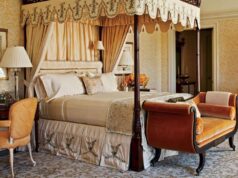The home as calling card is a well-worn metaphor for the private abodes of top interior designers. But the Shelter Island, New York, retreat of Esteban Arboleda is no slick showcase. “It’s not a laboratory,” says the decorator, associate partner at the celebrated Manhattan-based firm Haynes Roberts. “My house is my house. It’s a representation of who I am as a person, of my broad interests not just in my design life but in my life, period.”
Those idiosyncratic passions have found a worthy outlet for expression in Shelter Island Heights—a short distance but a world away from the swank and polish of the Hamptons homes for which Haynes Roberts is so beloved. Founded in the late 19th century as a summer getaway for members of the Brooklyn Methodist Church, and now listed on the National Register of Historic Places, this picturesque enclave is still dotted with its original seasonal cottages, designed in exuberant Victorian fashion with high-pitched roofs and gingerbread details. Over the decades, the salt air has taken its toll, but a carefree, communal spirit has endured—a little bit Brigadoon, a little bit Wes Anderson. “It’s out of a fairy tale,” Arboleda notes of the neighborhood, which he describes as “the witchiest, most mystical Scandinavian fantasy land.”
1970s Brazilian side chairs surround the dining room’s circa-1964 table by Silvio Coppola for Bernini; the framed artwork is a Christopher Wool poster.
He and his husband, David Haskell—a creative polymath who, in addition to being the editor in chief of New York Magazine and a celebrated ceramic artist, cofounded Kings County Distillery—happened upon the property by chance, absentmindedly scrolling Trulia on a visit to Long Island’s North Fork. “It was very different from anything else for sale,” Haskell recalls of the house, whose uninsulated Stick-style construction precludes winter occupancy, with baseboard heating that, in the warmest of weather conditions, can extend the spring–summer season into April and October. “It probably didn’t make sense for a lot of people but it was immediately clear to us that the place had personality. We just felt focused on specialness.”
After buying the property, which spans three original lots, two of them undeveloped, the couple set about preserving the character that had emerged across the home’s timber walls, floors, and chamfered beams. “So many people yearn for this patina,” Arboleda notes of the chipping paint and weathered finishes. “It was perfect, so relaxed and lived-in and unpretentious.” He and Haskell took special care to maintain that timeworn spirit, using a gentle bleach-infused tincture to strip away any dirt. “That first summer we did no work, we just got everything to a clean slate.”











